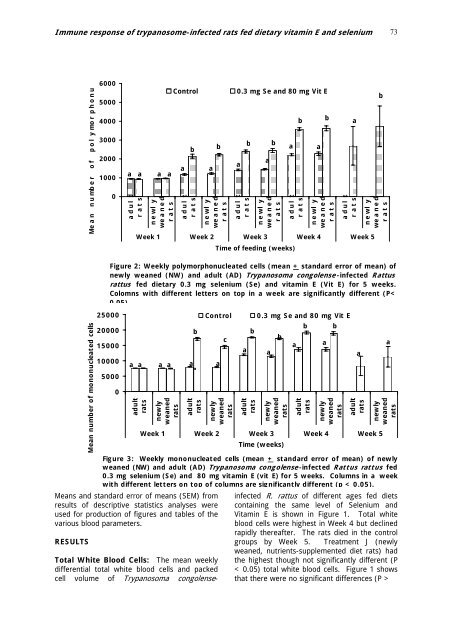ARI Volume 1 Number 2.pdf - Zoology and Environmental Biology ...
ARI Volume 1 Number 2.pdf - Zoology and Environmental Biology ...
ARI Volume 1 Number 2.pdf - Zoology and Environmental Biology ...
Create successful ePaper yourself
Turn your PDF publications into a flip-book with our unique Google optimized e-Paper software.
Immune response of trypanosome-infected rats fed dietary vitamin E <strong>and</strong> selenium<br />
Mean number of pol ymor phonu<br />
Mean number of mononucleated cells<br />
6000<br />
5000<br />
4000<br />
3000<br />
2000<br />
1000<br />
0<br />
a a a a<br />
adul t<br />
rats<br />
newl y<br />
we a n e d<br />
rats<br />
Control 0.3 mg Se <strong>and</strong> 80 mg Vit E<br />
a<br />
adul t<br />
rats<br />
newl y<br />
we a n e d<br />
rats<br />
adul t<br />
rats<br />
newl y<br />
we a n e d<br />
rats<br />
adul t<br />
rats<br />
newl y<br />
we a n e d<br />
rats<br />
adul t<br />
rats<br />
newl y<br />
we a n e d<br />
rats<br />
Week 1 Week 2 Week 3 Week 4 Week 5<br />
Time of feeding (weeks)<br />
Figure 2: Weekly polymorphonucleated cells (mean + st<strong>and</strong>ard error of mean) of<br />
newly weaned (NW) <strong>and</strong> adult (AD) Trypanosoma congolense -infected Rattus<br />
rattus fed dietary 0.3 mg selenium (Se) <strong>and</strong> vitamin E (Vit E) for 5 weeks.<br />
Colomns with different letters on top in a week are significantly different (P<<br />
005)<br />
25000<br />
20000<br />
15000<br />
10000<br />
5000<br />
0<br />
adult<br />
rats<br />
newly<br />
weaned<br />
rats<br />
b<br />
b<br />
a a a a a a<br />
adult<br />
rats<br />
a<br />
b<br />
a<br />
b<br />
a<br />
b<br />
Control 0.3 mg Se <strong>and</strong> 80 mg Vit E<br />
a<br />
c<br />
newly<br />
weaned<br />
rats<br />
a<br />
b<br />
adult<br />
rats<br />
newly<br />
weaned<br />
rats<br />
a<br />
b<br />
adult<br />
rats<br />
a<br />
b<br />
newly<br />
weaned<br />
rats<br />
a<br />
adult<br />
rats<br />
b<br />
73<br />
newly<br />
weaned<br />
rats<br />
Week 1 Week 2 Week 3 Week 4 Week 5<br />
Time (weeks)<br />
Figure 3: Weekly mononucleated cells (mean + st<strong>and</strong>ard error of mean) of newly<br />
weaned (NW) <strong>and</strong> adult (AD) Trypanosoma congolense-infected Rattus rattus fed<br />
0.3 mg selenium (Se) <strong>and</strong> 80 mg vitamin E (vit E) for 5 weeks. Columns in a week<br />
with different letters on top of columns are significantly different (p < 0.05).<br />
Means <strong>and</strong> st<strong>and</strong>ard error of means (SEM) from<br />
results of descriptive statistics analyses were<br />
used for production of figures <strong>and</strong> tables of the<br />
various blood parameters.<br />
RESULTS<br />
Total White Blood Cells: The mean weekly<br />
differential total white blood cells <strong>and</strong> packed<br />
cell volume of Trypanosoma congolense-<br />
a<br />
b<br />
a<br />
b<br />
infected R. rattus of different ages fed diets<br />
containing the same level of Selenium <strong>and</strong><br />
Vitamin E is shown in Figure 1. Total white<br />
blood cells were highest in Week 4 but declined<br />
rapidly thereafter. The rats died in the control<br />
groups by Week 5. Treatment J (newly<br />
weaned, nutrients-supplemented diet rats) had<br />
the highest though not significantly different (P<br />
< 0.05) total white blood cells. Figure 1 shows<br />
that there were no significant differences (P ><br />
a<br />
b<br />
a<br />
a

















